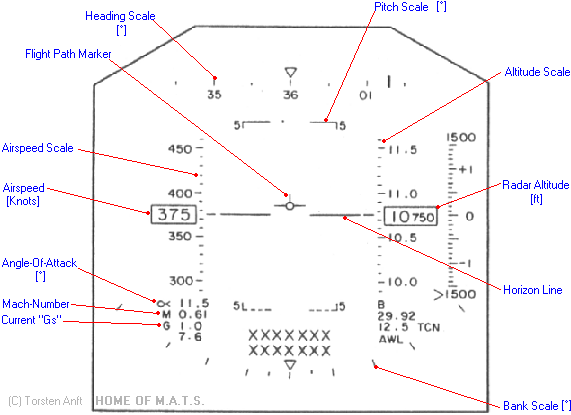F-14 Tomcat
videos below
This is a takeoff with afterburner from the port (left side) bow catapult. The landing gear and takeoff flaps are left extended since a closed-circuit pattern to a landing will follow. Otherwise both are retracted after takeoff. In 4 seconds the F-14 goes from zero speed to about 120 knots (140 MPH) leaving the deck. (Multiply knots by 1.15 for MPH.)
Again, as mentioned earlier, video quality is greatly reduced here--due to editing and keeping the file size down--compared to what is seen during flight in the simulator. Also, there is no audio.
An approach and landing is accomplished here with partial speed brakes (the first to be lowered), full flaps, and landing gear extended. The tail hook is also lowered and then later raised when on the deck so as to be able to taxi away from the arresting cable. Those familiar with carrier landing may notice the approach to be slightly low yet accurate. The goal is to snag the #3 wire. It appears that the #2 was caught, possibly even #1. But all's well that ends well.
The landing approach is begun at about 250 knots and then slowed further with brakes, gear, and flaps down to 150K on final approach. With that much drag on the airplane, power controls the descent, pitch attitude controls airspeed. With an abundance of power the airplane is very responsive to power changes, yet resists over-controlling due to the high drag configuration. Desired AOA (see HUD notes below) is 15 degrees.
Touchdown is accomplished without a landing flare. The airplane is simply flown onto the deck with the same descent rate as on the final approach. With visual and other cues, the descent angle will allow the #3 cable to be engaged by the tail hook.
Not every approach and landing is successful. Here the approach was low and fast and no cable was caught. Thus we have a "bolter." Generally, full power is applied passing over the arresting cables so that if missed the airplane is able to immediately takeoff (a "touch-and-go" in other aviation circles). If a cable is caught, it is immediately apparent, and power is reduced to idle.
STS Shuttle F-14 Tomcat
The position of the pilot seat is adjusted far forward to provide a bit more of a close-up view of the HUD. You'll see a graphic horizon line that matches with the actual horizon. After liftoff you'll see lines moving downward. Each represents increments of climb angle. In this case, though it can't be seen clearly, the airplane achieves a 50-degree climb angle before leveling off closer to the horizon.
The horizon line on the HUD perfectly matches up with the natural horizon. HUD information is an important part of a night deck landing.
Scale
Speed (kts)
AOA
MACH
Gs
Aircraft Path
Compass
Pitch
Radar
Altitude
Scale
Horizon
Bank
Scale
.________ VSI
NOTES
"Gs" G-force. Steep banks and pull-up can reach 6.5G, the military limit. 7.5G by manufacturer design.
"MACH" Speed reference to speed of sound: 760 MPH (660 kts sea level), 670 MPH (583 kts high altitude).
"AOA" Angle of Attack--the angle that wind meets the wing. At 74 degrees AOA the F-14 wing stalls.
"Path" Airplane symbol that shows climb, descent, and bank path reference to the horizon line.
"Pitch" Airplane path in degrees up or down reference to the horizon (level or climb or descent).
"VSI" Vertical speed of climb or descent. "1500" would be 1,500 feet per minute.
"Bank" Bank left or right in 10-degree increments beyond the first 10 degrees of bank.

